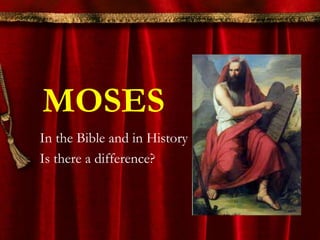
Moses
- 1. MOSES In the Bible and in History Is there a difference?
- 2. During the past couple of classes… You have read about the covenant that was made between God and his Chosen People You reviewed the Ten Commandments. You learned about the ways in which God revealed himself to Moses and his Chosen People.
- 3. Who was Moses? Moses: Hebrew for “drawn out”; refers to how the Egyptian princess who drew him out of the Nile from the basket used by his birth mother to hide him He escaped death after the Pharaoh declared that the first born of Hebrew slaves were to die He was born around 1520 B.C.; his birth was foretold by a prophecy Moses was raised in the royal court of the Pharaoh of Egypt
- 4. Who was Moses? His family was from the tribe of Levi – there were 12 tribes of Israel. Parents: Amram and Jochebed Siblings: Aaron and Miriam (both older) Wife: Zipporah, whom he met while in exile in Midian he had been exiled for coming to the defence of a Hebrew slave being beaten by an Egyptian, whom he killed. Children: a son, Gershom
- 5. The Story of Moses and Exodus The Exodus was a central event in Jewish history but was not written about until almost 250 years later. As with all other stories in the Bible, Catholics approach its reading CONTEXTUALLY and with a critical eye. We are not to focus on the details of the story, rather the religious truths.
- 6. The Story You Know… Moses returns to Egypt after God calls him Moses demands the release of Hebrew slaves and when the Pharaoh refuses, God brings forth the 10 Plagues Israelites are freed but later chased by the Egyptian army. Parting of the Red Sea. Wandering in the desert for 40 years Burning Bush Ten Commandments Promised Land
- 7. What Likely DIDN’T Happen… The parting of the Red Sea: Geographically, Moses and the Israelites were nowhere near the Red Sea; they were travelling more south In the original translation, the body of water is called “sea of reeds” = a marsh; most likely near the modern-day Suez Canal It is highly likely that Egyptian chariots got stuck in marsh mud, allowing the Israelites to get away It was referred to as a “miracle” because it was the beginning of new life for the Jews There have been many theories, both in favour and against the parting of the actual Red Sea
- 9. What Likely DIDN’T Happen… The burning bush: More of a symbol that represents the fire that was in Moses’ heart because of his desire to do God’s will in leading the Israelites to the Promised Land Fire is a typical image of God: powerful, vibrant, can’t touch it, transforms energy The burning bush is a symbol for all believers: the passion and love we all have for God
- 10. In the end… it doesn’t matter!(Mrs. Coz is well aware that some of you are sitting in your chairs shaking your heads and wondering what in the Bible is actually factual. Don’t worry – everything will be alright.)
- 11. What Exodus experience reveals to Moses and Us: God stands for freedom God choses us and we belong to him covenant God loves his people and invites us to return God reaches into our lives to lead us to wholeness God teaches us how to live well and forgives us when we fail
- 12. Your task: Read: The Holy Prophet Moses (a chapter from another textbook) Answer the accompanying questions and define the vocabulary words You may want to put a “star” on this worksheet on these term. Hint, hint… The questions will be taken up in class tomorrow – be prepared…
Hinweis der Redaktion
- *Note: Where students need not copy, it has been indicated in the notes beneath the slide. Otherwise, assume students must copy. *Scroll to the next slide using spacebar, arrow keys are return key
- Students do not need to write the contents of this slide…
- Students do not need to copy; please read aloud while they follow along
- Students do not need to copy this slide.